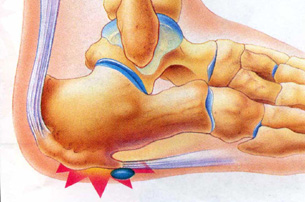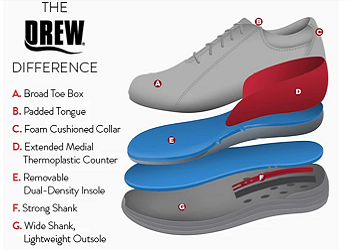Heel Spurs
What Are Heel Spurs?
A spur is a calcified bone deposit that can occur on any bone of the body.
A spur on the heel, detected by X-ray or through physical examination, is actually a calcification on the calcaneus, sometimes referred to as the “heel bone”, which combines with the talus to form the back of the foot.
A spur may form on the bottom of the calcaneus, just above the ligament that supports the arch of the foot, known as the plantar fascia. Or, it may form on the back of the calcaneus, just below the spot where the Achilles tendon attaches to the bone.

What Are the Symptoms of Heel Spurs?
The spur itself is not painful, but the location of the deposit can cause pain in other portions of the foot.
Spurs on the bottom of the heel bone are commonly associated with a condition known as plantar fasciitis (inflammation of the plantar fascia), which affects several million Americans annually.
If the spur is accompanied by plantar fasciitis, pain is most severe during the first few steps of the day and occurs on the underside of the heel.
If the spike forms on the back of the calcaneus, it can cause pain in the Achilles tendon and lead to tendonitis. If the deposits are large, they can cause irritation of the skin, due to increased pressure against the shoe.
What Causes Heel Spurs?
A spur is a symptom of the body’s desire to repair itself. Extra bone is added over time, as long as we are healthy and well nourished.
In some cases, the extra bone forms in an isolated spot due to pressure, rubbing or stress that occurs over a long period of time.
Women that frequently wear high-heeled shoes and pumps are prone to have spurs on the back of the heel-bone due to the tightness and pressure. This is so common that the spurs are sometimes called “pump bumps”
Plantar fasciitis can cause the bony deposits. As the ligament becomes tight and pulls on the heel, the bone attempts to make repairs and the deposit forms.
How Are They Treated?
Heel spurs must sometimes be removed in order to treat severe or chronic Achilles tendonitis. Removal is not normally recommended for plantar fasciitis; instead, the plantar fasciitis is treated.
Avoiding shoes that are tight in the heel area is helpful, as is choosing styles that hit at a lower or higher point than the location of the spur.
Air or gelatin cushioned insoles provide pain relief and help to support the arch, which helps to heal plantar fasciitis, too.
Some of the products that are recommended include Foot Smart Plantar Fasciitis Support. The brace provides additional support for the arch of the foot and the ankle.
Heel spurs will not go away, but they do not need to cause pain. Wearing appropriate shoes and cushiony insoles is the key to being pain-free.


